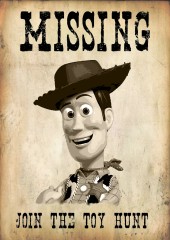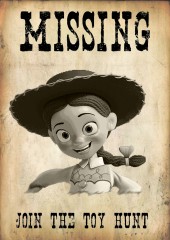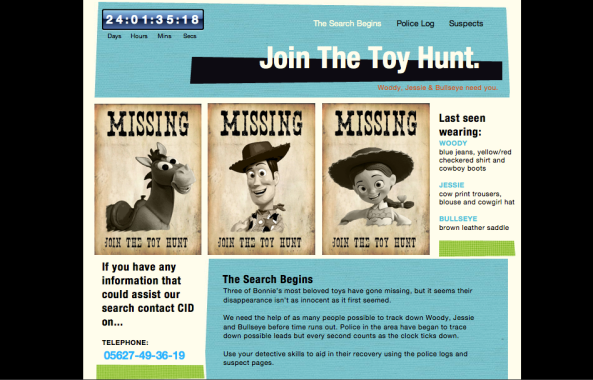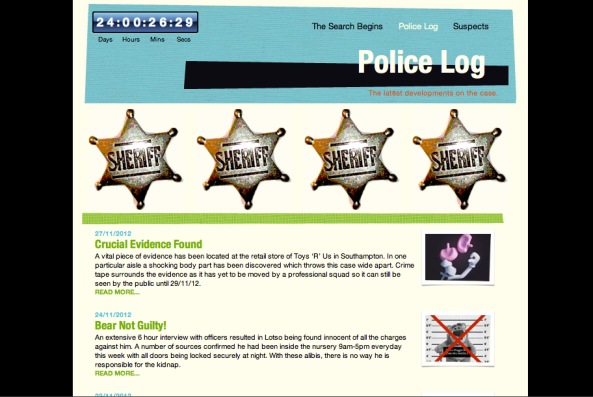Treatment
My viral marketing campaign is going to build on the artificial reality of the Toy Story world. There have been three, hugely popular movies with the last one ending with the famous group of characters being given to a new child, my marketing will therefore build on from this, creating a backstory that can entice old fans and new children alike. The name of the campaign will be ‘Toy Hunt’ in which people are invited to join the search for three of the beloved characters from the films (Woody, Jessie and Bullseye) after finding out they have gone missing. The viral marketing wouldn’t be aimed at an audience too young because ten year olds presumably wouldn’t be able to unlock clues and go on scavenger hunts, logistically it makes much more sense to engage a slightly older market and because the characters are so well known to hardcore fans they are a perfect demographic. The first film was released in 1995 so capturing a teenage audience (between the age of 16 and 20) is important, the campaign wouldn’t be gender specific but would need ‘fanatics’ i.e active, heavily enthusiastic and energetic individuals. This would mean they are dedicated to hunting down the famous figures and the viral marketing in effect would form an online community between fans all with one objective in mind, the age group previously described are also very involved in the evolution of technology i.e web 2.0, blogs etc. so are more likely to immerse themselves fully in the artificial reality than adults. Having this midpoint age group between children and adults means that whilst the idea is young at heart, I can make the campaign look good for a media savvy audience and it doesn’t have to be childish.
Traditional, old style wanted posters will appear for each toy in public places such as train stations and shopping centres, which would hopefully gather an air of interest around the upcoming sequel. They won’t contain a lot of information in order to keep a level of mystery around the movie but instead, feature just a headshot, the heading ‘missing’ and tag line, ‘Join the toy hunt’. At first audiences will be lulled into the story that the toys are just missing but after the second viral technique is released, it will become evident that there are suspicious circumstances in which Woody, Jessie and Bullseye have disappeared. This will be a short (25 second) teaser video where the three characters are shown to be held hostage somewhere. They have tape over their mouth and around their hands/feet, the clip has a vintage style filter over it which maintains synergy with the posters and sinister music can be heard, all put together to make an eery piece of film. The hostage video sends viewers to the fake website i have created (www.toyhunt.co.uk), the main part of the artificial reality. Here, people can explore pages which give information on possible suspects and a police log of updates on the case e.g. evidence collected etc. To make the viral campaign fully immersive, I would send out cards of the criminal mugshots, missing posters and western badges to key influences so they can spread news about the campaign however due to limited resources I could only theoretically map this idea out rather than physically print and post the items. A similar concept I would of liked to include would be a scavenger hunt in which the website hints and directs the target audience to a particular aisle in the huge retail store ‘Toys R Us’, where they would find the next piece of the puzzle; an article of the kidnapper’s clothing. It would be surrounded by crime tape and gamers would have a limited amount of time in which they could view the piece of evidence but would hopefully get people talking.
I spent one lesson producing these simple Wanted posters. Each image has been found online but edited through photoshop and using tools like ‘posterise’ to give it a ‘sepia’ effect, combining this with the typography used, it is hoped that people would immediately associate the posters with a wild western style. To give an example of how the general public would possibly see these pieces of promotional material in a real life situation, you can view a moving image advertisement where the posters appear in a London tube station below.
Click here to see interactive ad.
The second piece of viral marketing, as briefly mentioned above, was through the platform of video. The hostage clip will act as a teaser with the intention of drawing attention to the toy hunt campaign because it is quite unconventional and different. Not many people would expect to see a children’s movie promoting their new film through such a strong method with a very criminal related theme. The video would be uploaded onto Youtube, a website which hundreds of thousands of people have access to everyday and with the message ‘If you want to see these toys alive, log onto http://www.toyhunt.co.uk’ should push the viral experience on further by picking up a bigger following. The video can be seen below.
I started developing a concept for a fake website following the ‘Toy Hunt’ theme in todays lesson. The colours and general feel of the site are lively and fun so that the campaign isn’t made too sinister, after all it is for a children intended movie. Three pages have been created, the first being a general home page, the second being a suspect page for a number of famous villains in the series with a little backstory attached to each including elements like their motive and means for being involved in the gang’s disappearance and finally a police log of activities. I will play with the IWeb software more in the future and edit colours, fonts, add images etc. to make the site more impressive.
Here is the completed homepage for my toy hunt website. The previously seen wanted posters can be seen a long with concise chunks of text giving info on what the toys were last seen wearing and how people can also contact the ‘police’. The number shown which encourages people to contact CID would take audiences to an automated message offering a small clue on the case. There is also a greeting from the website creator, briefing visitors on what they can do to help.
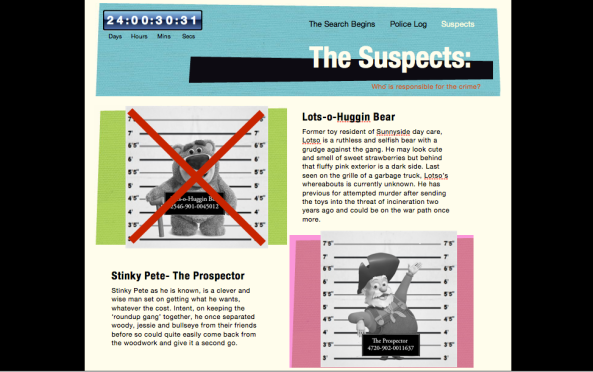
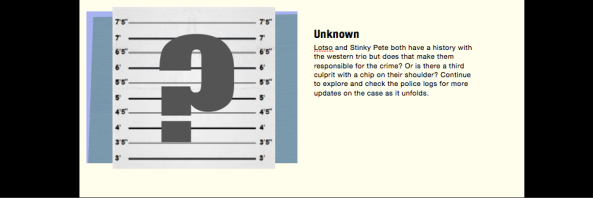 The suspect page is a fun page where characters are explore in depth, I created the criminal mugshot images on Photoshop, which I believe are a nice touch because they make a serious topic a bit more lighthearted. The colours and style of the page match what audiences would expect to see from a Toy Story themed website so conventionally the page is successful and playful at the same time.
The suspect page is a fun page where characters are explore in depth, I created the criminal mugshot images on Photoshop, which I believe are a nice touch because they make a serious topic a bit more lighthearted. The colours and style of the page match what audiences would expect to see from a Toy Story themed website so conventionally the page is successful and playful at the same time.
The Police Log page on the Toy Hunt website would be where any new information on the artificial story could be posted. It keeps the experience on going for ‘players’ because they will have to regularly check the page to see if any developments occur. The text is entertaining and easy to read so should interest Toy Story fans.
Altogether, with these three components, the poster collection, the viral video and the website pages, this campaign based on the world of Toy Story is fully immersive and interactive for consumers. Key influences and the mystery of the missing posters will start the ‘virus’ and with a feed of information gradually fed to the public the story will unfold and gather interest a long the way. Hopefully with the extensive and planned out marketing strategy, the film would receive a lot of publicity from the older teen market who can be brought back to their youth rather than just younger children.
